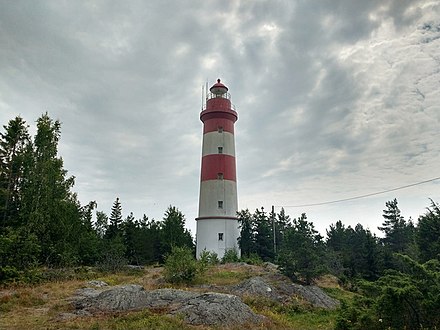Ostrobothnia (Swedish: Österbotten, Finnish: Pohjanmaa) is a stretch of coastal Western Finland. The historic province of the same name has been split in parts; this is the one where Swedish-speakers are found.
Cities
The Swedish name is given first, then the Finnish, also the latter in bold when Finnish is the majority language.
- Vasa / Vaasa — the regional capital
- Jakobstad / Pietarsaari, a nice small port town
- Kaskö / Kaskinen — Finland's smallest town since its chartering in 1785
- Kristinestad / Kristiinankaupunki, with a lovely wooden old town
- Nykarleby / Uusikaarlepyy
- Närpes / Närpiö, known for tomatoes and an archaic dialect
Municipalities
- Storkyro / Isokyrö
- Korsholm / Mustasaari – Old Vaasa, suburbs and countryside
- Korsnäs
- Kronoby / Kruunupyy
- Laihela / Laihia
- Larsmo / Luoto – islands by Jakobstad
- Malax / Maalahti
- Pedersöre – countryside by Jakonstad
- Vörå / Vöyri
Understand
Ostrobothnia is a region centred around Vaasa on the west coast of Finland, consisting of 17 municipalities. It borders with the regions Central Ostrobothnia, Southern Ostrobothnia and Satakunta. Ostrobothnia is the only region in Finland (except Åland) that has a majority of Swedish-speakers (about 52%).
The linguistic gap towards the Finnish, the cultural one to Swedish-speaking in the southern cities, the proximity to Sweden and the availability of radio and television from there have given the locals a regional identity separate from that of the southerners, only to a degree diluted with greater modern mobility.
The area is dominated by agrarian culture in contrast to the forestry-dominated inland. Ostrobothnia was hit hard by bad economic conditions and famine during the 19th century and thousands of people emigrated to America. Generally, though, this region is and has been quite wealthy, with self-confident independent farmers.
The bigger towns have a significant Finnish-speaking population due to industrialisation, as workers have moved here from the Finnish-speaking inland, while those with old local roots generally are Swedish-speaking.
Talk
The bigger towns, such as Vaasa and Jakobstad, are bilingual and you will get along on Swedish or Finnish with most of the population (and at least in shops, etc.). Generally only either language is spoken in rural communities: Finnish in Laihia, Isokyrö and Vähäkyrö, Swedish in the rest. In fact, the mother tongue of most rural people in the area is some Swedish dialect, often incomprehensible to many Swedish speaking from the south, but people will change to the Swedish learnt at school (and heard from Swedish and Finnish television) when meeting them.
English is known as in other parts of the country. No problem.
Get in
The main road through the region is E8 (here national road 8) along the coast, from Turku via Oulu and Tornio to Norwegian Tromsø. Road 3 leads from Helsinki via Tampere to Vaasa.
Trains serve Vaasa and Jakobstad from the inland, and Vaasa and Jakobstad are served by local airports.
There is a ferry from Umeå to Vaasa, across the Gulf of Bothnia.
By air
There are flights from Helsinki and Stockholm to Vaasa airport. There is also an airport in Kronoby, which serves the cities of Kokkola and Jakobstad.
By train
There are train connections to Vaasa and Jakobstad, the latter with bus for the last stretch. Most connections require changing trains in Seinäjoki.
By bus
There are several coaches a day along the main roads, some from neighbouring regions. Some services make detours to nearby towns, others keep to the highway, with stops at the main junctions.
By car
The main routes are national roads 3 (E12) and 8 (E8). A more rural route with less traffic from Helsinki is via roads 1, 2, 12, 44, 67 and 3 to Vaasa. For the southern parts, turn to road 672 in Jalasjärvi and continue by road 67, for the northern parts instead turn to road 19 and drive via Seinäjoki and Kauhava.
By boat
There is a ferry to Vaasa from Umeå, Sweden: mostly day services, 4½ hr.
Arriving by small craft by the coast or from Sweden is a nice option, although the archipelago is challenging. See Boating in Finland.
Get around
There are coaches and buses covering most of the region. See Matkahuolto and the individual city articles.
A car (or bike) is useful for reaching countryside off the main roads.
By taxi
- National smartphone apps: Valopilkku, 02 Taksi
See

- Kvarken Archipelago, a UNESCO World Heritage Site.
- The ship Jacobstads Wapen in Jakobstad, built using 18th century blueprints by famous naval architect af Chapman
- Finland's statue of freedom in Vaasa, where the "white" government resided during the civil war. The civil war is still a touchy issue, with "whites" usually seeing it as part of Finland's struggle for independence.
- Kuddnäs, the birthplace of the author Zacharias Topelius in Nykarleby. The Swedish speaking Topelius was important in creating the Finnish identity in the 19th century.
- Replot bridge, the longest in Finland, outside Vaasa
Do
- Drive along the road of seven bridges from Jakobstad via Larsmo to Kokkola
- Have fun at Tropiclandia water park in Vaasa
- Paddle a kayak around the Kvarken heritage.
Eat
Drink
Stay safe
The region of Ostrobothnia is safe.
Respect
Religion plays a much more important role in many communities than in southern Finland. Especially the Laestadian pietist revival movement is strong in some areas.
Mink and fox farming (for furs) is an important trade in the region, so animals' rights can be a touchy issue.